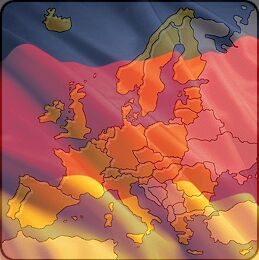
Germany Redrawing Europe’s Borders
Reminiscent of Nazi Germany practices, German maps are again being redrawn to include nations of middle Europe in a greater Germany.
A Dec. 22, 2006, German-Foreign-Policy.com report reveals that German cartographers have made plans for a “large-scale reordering of Europe.”
These maps were produced at the request of the German Foreign Office and are intended for the political and administrative use of German authorities. In these presentations, Germany dominates the area called “Middle Europe” as the country with the largest population.
In these maps, Mitteleuropa includes former Yugoslavia as far as Albania and 13 other Eastern European countries. German-Foreign-Policy.com explained:
According to the themes developed, “areas historically ruled by the predominantly German-speaking states” are the most “suitable” for inclusion in the “cultural space (Kulturraum) of Middle Europe.”
The charts were commissioned by the German Foreign Office and discussed by the Standing Committee for Geographical Names, which, according to the German-Foreign-Policy report, “enjoys state funding and publishes authoritative guidance for geopolitical purposes.” Up to now, the report stated, such plans have only been debated by “right-wing extremists and out-and-out revisionists.”
To excuse the likeness of the maps to Nazi plans for Europe, the presentations hearken back to the German Reich—the Holy Roman Empire that encompassed the Continent for a thousand years—for the authority to lay claim to such an area. German-Foreign-Policy stated (emphasis ours):
The accompanying charts designate parts of France, Denmark, the whole of Luxemburg, Switzerland and upper Italy to the political fiction of a German-dominated center. Naturally, Poland, the Czech Republic and Hungary are taken into the project. Various areas are claimed as part of “Middle Europe” because they were originally part of the German Reich, “quite separately” from their later conquest by the Nazis. German-foreign-policy.com is publishing excerpts from these charts which bear a worrying similarity to projections made by the predecessor states of the German Federal Republic. …
Over many pages the concept displays a germano-centric view of Europe in which the Germans are seen as “settlers and bearers of culture outside the present German-speaking areas.”
The article went on:
[T]his revisionist framework stands in the tradition of similar German attempts to base demands for leading power status in Europe, founded on reviving aspects of the Middle Ages. Elite German geographers reached a high point in these endeavors when they placed their services at the disposal of the Nazi regime. … The resulting maps were used, among other things, to plan the attack on Poland and assisted greatly in the expulsion campaigns against the Polish population. The new charts recall the time when Poland was seen as a reservoir of slave labor in the Nazi version of a teutonic “Middle Europe.”
Taken together with other movements underway in Germany, a distinct trend emerges. The concept of victimhood is becoming increasingly popular, where Germany is more and more being portrayed as a victim in World War ii rather than an aggressor. This in turn is feeding an emerging German nationalism. A historical exhibition was opened in Berlin last June reportedly to help restore the country’s lost sense of national identity. Recent weeks have seen the German government stand by while the Prussian Claims Society, on behalf of individual Germans, files suits with the European Court of Human Rights to demand Poland pay compensation for property lost when Eastern Europe’s borders were redrawn at the end of World War ii.
One need not wonder why Poland is getting nervous. The rest of the world would do well not to ignore such developments in Germany either.
Prophecy tells us that one final resurrection of the Holy Roman Empire—with Germany at the helm—is yet to occur. It is for this reason that Germany’s recent interest in reviving memories of its former grandeur is something we should watch closely.
